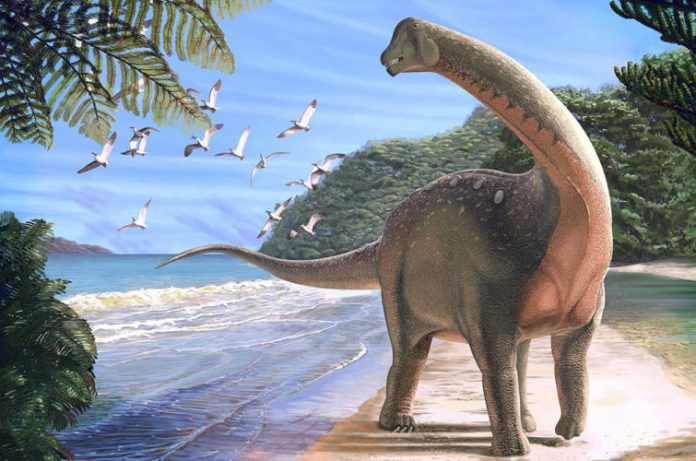A new species of dinosaur found in Egypt’s Sahara Desert may help solve the mystery of the creatures’ evolution in Africa, scientists say.
Found in Egypt’s Western Desert, Mansourasaurus shahinae weighed almost as much as a bull African elephant and was as long as a bus. It tromped across Africa during the Late Cretaceous, between 66 and 100 million years ago—a period that is a blank spot in the records for African dinosaurs, George Dvorsky reports for Gizmodo.
Although it may not look particularly different than other long-necked ancient beasts you may have seen—that’s exactly what’s caught paleontologist’s attention. During this period, many researchers believe that Africa had drifted away from other landmasses as an isolated “island continent,” according to the new study, published this week in the journal Nature Ecology and Evolution. But others think there may have still been some connections or mixing of species. The remarkable similarity of this newly discovered African species to sauropods found in both Europe and Asia suggests that creatures co-mingled much later than expected, reports National Geographic’s Sarah Gibbens.
“When I first saw pics of the fossils, my jaw hit the floor,” paleontologist and paper co-author Matt Lamanna of Carnegie Museum of Natural History says in a press release. “This was the Holy Grail—a well-preserved dinosaur from the end of the Age of Dinosaurs in Africa—that we paleontologists had been searching for for a long, long time.”
The fossil is the most complete dinosaur skeleton yet discovered in Africa from the late Cretaceous, reports the BBC’s Helen Briggs. It includes part of a skull, lower jaw, neck and spine vertebrae, ribs, partial shoulder, forelimb, and hind foot, and pieces of dermal plates. This completeness allowed researchers to analyze the dinosaur’s anatomy, comparing it to other creatures that lived at the time in Europe and Asia.
“It shows Africa wasn’t this strange lost world of dinosaurs that lived nowhere else,” Lamanna tells Briggs. “That at least some African dinosaurs had other close relations in other continents at the time.”
This runs counter to the last African dinosaur discovery, Sarah Sloat reports for Inverse. When researchers found a 66-million-year-old Chenanisaurus barbaricus, it was so distinct that they concluded African dinosaurs must have been isolated from other regions.
Mansourasaurus was a Titanosaur, a subgroup of the long-necked plant-eating sauropods that roamed the Cretaceous. This group includes some of the largest dinosaur species, including Argentinosaurus, Dreadnoughtus, and Patagotitan mayorum, writes Dvorsky. Although large, Mansourasaurus was actually relatively small compared to its kin.
Researchers are thrilled about the find, and are hopeful they can continue to tease out the lineage of these ancient beasts. “It’s like finding an edge piece that you use to help figure out what the picture is, that you can build from,” says Field Museum research scientist and study co-author Eric Gorscak in the press release. “Maybe even a corner piece.”















